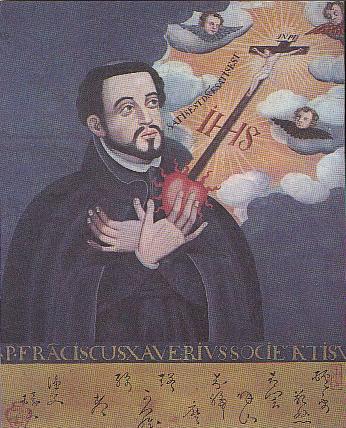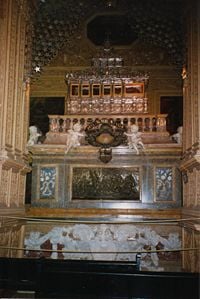Francis Xavier
| Francis Xavier | |
|---|---|
| Apostle to the Far East | |
| Born | April 7, 1506 in Javier, Spain |
| Died | December 2,1552 in China |
| Venerated in | Roman Catholic Church, Lutheran Church |
| Beatified | October 25, 1619
by Paul V |
| Canonized | March 12, 1622
by Gregory XV |
| Feast | December 3 |
| Attributes | crucifix; preacher carrying a flaming heart; bell; globe; vessel; young bearded Jesuit in the company of Saint Ignatius Loyola; young bearded Jesuit with a torch, flame, cross and lily |
| Patronage | African missions; Agartala, India; Ahmedabad, India; Alexandria, Louisiana; Apostleship of Prayer; Australia; Bombay, India; Borneo; Cape Town, South Africa; China; Dinajpur, Bangladesh; East Indies; Fathers of the Precious Blood; foreign missions; Freising, Germany; Goa India; Green Bay, Wisconsin; India; Indianapolis, Indiana;Sophia University, Tokyo, Japan;Joiliet, Illinois; Kabankalan, Philippines; Nasugbu, Batangas, Philippines; diocese of Malindi, Kenya; missionaries; Missioners of the Precious Blood; Navarre, Spain; navigators; New Zealand; parish missions; plague epidemics; Propagation of the Faith |
Template:Jesuit Saint Francis Xavier (Basque: San Frantzisko Xabierkoa; Spanish: San Francisco Javier; Portuguese: São Francisco Xavier; Chinese: 聖方濟各沙勿略) (7 April, 1506 - 2 December, 1552) was a pioneering Roman Catholic Christian missionary and co-founder of the Society of Jesus (Jesuit Order). The Roman Catholic Church considers him to have converted more people to Christianity than anyone else since St. Paul.[citation needed]
Life
Was born Francisco de Jasso y Azpilcueta in the castle of Xavier (or Xavero) near Sangüesa and Pamplona, in the Kingdom of Navarre. He was born to an aristocratic family of Navarre. He was the youngest son of Juan de Jasso, privy councillor to King John III of Navarre (Jean d'Albret), and Maria de Azpilcueta y Xavier, sole heiress of two noble Navarrese families. He was born close to the town of Sanguesa, on 7 April, 1506, according to a family register. Following the Spanish surname custom of the time, he was named after his mother; his name is accurately written Francisco de Xavier (Latin Xaverius) rather than Francisco Xavier, as Xavier is originally a place name. In 1512, many fortresses were devastated, including the family castle, and land was confiscated. Francis' father died in 1515.
At age 19, Francis Xavier went to study at the University of Paris, where he received a licence ès arts in 1530. He furthered his studies there in theology and became acquainted with Ignatius Loyola. Xavier, Ignatius, and five others founded the Society of Jesus on 15 August, 1534, taking a vow of poverty and chastity at a site now in the Montmartre area of Paris.
Francis Xavier and his friends then went to Italy, gaining the approval of the Pope to found the Company of Jesus, or Jesuits as they were later called.
Francis Xavier's work initiated permanent change in eastern Indonesia, where in 1546-1547 he worked in the Maluku region among the people of Ambon, Ternate, and Morotai (or Moro), and laid the foundations for a permanent mission. He continued his missionary work in Japan. After he left Maluku, others carried on his work and by the 1560s there were 10,000 Catholics in the area, mostly on Ambon. By the 1590s there were 50,000 to 60,000.[1]
Many believe Francis Xavier is a saint who brought the Christian faith to Asia.
Francis Xavier is commonly known as 'St. Francis Xavier,' 'the Patron Saint of the East.' He is still prayed to and honored as the pure representative of Jesus Christ (his remains are preserved and still venerated to this day) and his gospel by Christians all over the world. There are innumerable hospitals, schools, and other institutions in India named after him.
Death
On 21 November, on Shangchuan Island, he fainted after celebrating Mass. He died on 3 December, 1552, at age 46, without having reached mainland China.
He was first buried on a beach of Shangchuan Island. His intact body was taken from the island in February 1553 and was temporarily buried in St. Paul's church in Malacca on 22 March, 1553. An open grave in the church now marks the place of Xavier's burial. Pereira came back from Goa, removed the corpse shortly after April 15, 1553, and moved it to his house.
On 11 December, 1553, Xavier's body was shipped to Goa. The body is now in the in the Basilica of Bom Jésus in Goa, where it was placed in a glass container encased in a silver casket on December 2, 1637.
The right forearm, which Xavier used to bless and baptize his converts, was detached by Pr. Gen. Claudio Acquaviva in 1614. It has been displayed since in a silver reliquary at the main Jesuit church in Rome, Il Gesù[2].
Legacy
St. Francis Xavier is noteworthy for his missionary work, both as organizer and as pioneer. By his compromises in India with the Christians of St. Thomas, he developed the Jesuit missionary methods along lines that subsequently became a successful blueprint for his order to follow. His efforts left a significant impression upon the missionary history of India and, as one of the first Jesuit missionaries to the East Indies, his work is of fundamental significance to the propagation of Christianity in China and Japan.
Pope Benedict XVI said of both Ignatius of Loyola and Francis Xavier: "not only their history which was interwoven for many years from Paris and Rome, but a unique desire — a unique passion, it could be said — moved and sustained them through different human events: the passion to give to God-Trinity a glory always greater and to work for the proclamation of the Gospel of Christ to the peoples who had been ignored."[3]
Beatification
Francis Xavier is a Catholic saint. He was beatified by Paul V on October 25, 1619, and was canonized by Gregory XV on March 12, 1622, at the same time as Ignatius Loyola. He is the patron saint of Navarre, Spain; Nasugbu, Batangas, Philippines; Australia; Borneo; China; the East Indies; Goa, India; Japan; New Zealand, and of missionaries. His feast day is December 3.
Educational institutions
- St. Xavier's College, Mumbai, India. St. Xavier's College is one of India's oldest and Mumbai's most famous college.
- Xavier University (Cincinnati), founded in 1831, is one of 28 member institutions of the Association of Jesuit Colleges and Universities in the United States and is the fourth oldest (sixth oldest Catholic college).
- In 1839, Theodore James Ryken founded the Xaverian Brothers, or Congregation of St. Francis Xavier (CFX). Over 20 colleges or high schools in the United States are Xaverian Brothers Sponsored Schools (XBSS).
- St. Francis Xavier University, named after him, is a small university in eastern Canada established in 1853. Students at this university celebrate the life of St. Francis Xavier every year on December 3. It is also the date that senior students receive their university ring (X-Ring), which is marked with an "X" and is recognized around the world.
- Xavier School in the Philippines is named after him as well. The school was established as a missionary school, by Jesuits expelled from China, continuing the work of St. Francis Xavier.
- The Pontifical Xavierian University in Bogotá, Colombia.
Miscellaneous
- Francisco Xavier is one of the most common given names in Spain and Hispanic countries.
- In its English variant, Francis Xavier, it is usually abbreviated to Francis X. Well-known people with this name include Francis X. Bushman, Admiral Francis X. McInerney and Francis X. DiLorenzo, the Italian judge Francesco Saviero Borrelli. As a spin-off, Xavier itself became a male name popular in Portugal, Brazil, France, Belgium, and southern Italy. In Austria and Bavaria the name is spelled as Xaver (pronounced Ksaber and often used in addition to Francis as Franz-Xaver.
- Many churches all over the world have been named in honor of Xavier. One notable church is the Basilica of St. Francis Xavier in Dyersville, Iowa. It is one of only 52 minor basilicas in the United States, and the only one outside a metropolitan area.
- The Javierada is an annual pilgrimage from Pamplona to Xavier instituted in the 1940s.
- The Dutch student fraternity KSV St. Franciscus Xaverius in Wageningen (Province of Gelderland) is named after him.
- Xavier is one of the few English names starting with X.
- The X-Men comic book character, Charles Francis Xavier (Professor X), is probably named after him.
- The station Saint François Xavier, on Line 13 of the Paris Métro, is named after him.
- A character based on Xavier appears in the game Sengoku Basara as Xavi/Zabii (Q-Ball in the American version).
- An episode of the anime series Samurai Champloo portrays a con-man posing as Xavier's descendant, which allowed him to string along a village of Christians in Edo period Japan to hide more devious goals.
General
Notes
- ↑ Ricklefs, M.C. (1993). A History of Modern Indonesia Since c.1300, 2nd Edition. London: MacMillan, p.25. ISBN 0-333-57689-6.
- ↑ Cappella di san Francesco Saverio, at the official website of Il Gesù. Text in Italian.
- ↑ Address of Benedict XVI to the Jesuits, April 22, 2006.
See also
- Jesuit China missions
- Catholicism in China
- List of people on stamps of Ireland
- Religion in China
- Jesuit China missions
- Christianity in China
- Goa Inquisition
- Exploration of Asia
- Flying Saints
Namesakes
- St. Xavier, Montana
- St. Xavier High School
- St. Xavier's College
- Xavier University (Cincinnati)
Catholic missionaries in China
- Michel Benoist
- Giuseppe Castiglione
- Armand David
- Matteo Ricci
- Johann Adam Schall von Bell
- Ferdinand Verbiest
- St. Francis Xavier
Protestant missionaries in China
- See separate article List of Protestant missionaries in China.
External links and references
- Catholic Encyclopedia, 1909 on St. Francis Xavier
- St. Francis Xavier - Pictorial Biography
- This article incorporates material from the Schaff-Herzog Encyclopedia of Religion
- François Xavier(in French)
- St. Francis of the Millennium
- The Goa Jesuit Province of the Society of Jesus - The Jesuits in Goa
- The feast of St Francis Xavier in Goa
- St Francis Xavier and Malacca
- Picture of Shangchuan island. The chapel marks the location of his death
- Another picture of the church on Shangchuan island
- Old map of Shangchuan island
- St. Francisco Xavier
- The Miracles of St Francis Xavier by John Hardon, SJ
- St Francis Xavier: History of His Incorrupt Body
- Brief History of St Francis Xavier
- Patron Saints @ Catholic Fourm
- Web sites abour San Francis Xavier (Spanish)
Credits
New World Encyclopedia writers and editors rewrote and completed the Wikipedia article in accordance with New World Encyclopedia standards. This article abides by terms of the Creative Commons CC-by-sa 3.0 License (CC-by-sa), which may be used and disseminated with proper attribution. Credit is due under the terms of this license that can reference both the New World Encyclopedia contributors and the selfless volunteer contributors of the Wikimedia Foundation. To cite this article click here for a list of acceptable citing formats.The history of earlier contributions by wikipedians is accessible to researchers here:
The history of this article since it was imported to New World Encyclopedia:
Note: Some restrictions may apply to use of individual images which are separately licensed.

